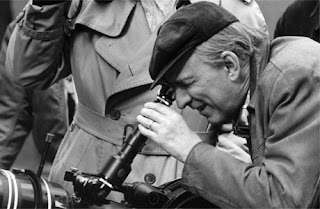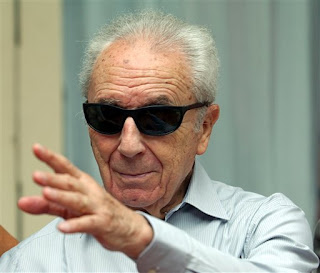Masterminds in action
Contemporary filmmakers Ingmar Bergman and Michelangelo Antonioni explored the dynamics of human relationships and redefined cinematic language in a vocabulary, all their own. K. Jeshi writes on Konangal’s tribute to them
Photos: S. Siva Saravanan

Bibi Andersson
“My creativity is terribly childish … it is a dialogue with my childhood,” says Ingmar Bergman in a recorded interview. For those who love Bergman, his work is poetry. He deliberately wipes a couple of lines in-betwee n so that you can fill in the blanks and enjoy the poem. The European master directed theatre and opera for 60 years and penned 50 original scripts. He passed away on July 30 in Sweden, and the void left behind is hard to fill. His films are completely personal and deal with the complexities of human mind and search for answers. Konangal Film Society made the tribute a memorable experience. Bergman’s classic, The Virgin Spring (1960) that fetched him his first Academy award, and the masterpiece Persona (1966) were screened at Kasturi Sreenivasan Art Gallery. A documentary on Bergman brought him closer to his fans.
Towards enlightenment

Liv Ullman
Adapted from a 14th century Swedish legend by screenwriter and novelist Ulla Isaksson, The Virgin Spring affirms faith, humanity and atonement. Bergman narrates the conditions in the transitional era of the Middle Ages. It begins with Karin (Birgitta Petersson) and Ingeri (Gunnel Lindblom) who are sent to church by their mother (Birgitta Valberg) and father (Von Sydow), strict Christians.
Ingeri is jealous of the attention lavished on Karin and tricks her naïve stepsister into continuing the journey alone. Karin encounters two herdsmen who rape, and kill her. A boy is witness to the crime. Eventually, the girl’s father takes revenge and as penance, vows to build a church. “He juxtaposes contradictions and opposing views only for our interpretation and intellectual progress,” says D. Anandan, film buff. He shows two levels of violence — the physical one of the herdsmen and the human meanness between the sisters, a reminder that we are always under threat of such violence. Another film buff said the film raised the question, ‘Should I believe in God or not?’
“It captured the conflict between religions and the way of life then,” said Rajeev Kamineni of Oxford Bookstore. The cinematography of Sven Nykvist captured the ruggedness of the polar country.
Persona, considered one of his central works on Modernism, explores an encounter between two women — Elisabet Vogler (Liv Ullman) , a successful actress who has become mute during a performance of Electra, and sister Alma played by Bibi Andersson (Alma means soul in Spanish and Portuguese), the nurse who cares for her. Bergman had said: “Persona saved my life — that is no exaggeration. If I had not found the strength to make that film, I would probably have been all washed up. One significant point: for the first time I did not care in the least whether the result would be a commercial success...”
Noted film critic Susan Sontag had called it “Bergman’s masterpiece”. Though the film has been variously interpreted, critics agree that it explores the intricacies of the doctor-patient relationship, in particular the phenomenon of transference. While Elisabet is ostensibly the patient, her silence suggests a reversal — in psychoanalysis the doctor is silent and the patient speaks. Thus Alma might be seen as the patient and Elisabet, the silent analyst. The interpretation that the two are the same is shown in a famous shot, the juxtaposition of Alma’s and Elisabet’s faces to form one image. The prevalent use of single camera shots throughout film helps the audience study the characters’ faces and the extremely tight close-ups illustrate the theme of psychological deconstruction.
Studying minds
When Pon. Chandran of Konangal said: “As the movie progresses, we start wondering if Alma is the patient,” many in the audience agreed. “His filmmaking is a blend of cinema and theatre; one complements and supplements the other beautifully. In Persona, he exposes the conflict between the inner complexities and outside appearances.”
The face is the index of the mind and the film captures this, said another film lover. “The compassion they share is so strong that one person loosens up to accommodate the other inside her to give peace,” he added.
D. Anandan pointed out that as said by Susan, the director merges reality and fantasy seamlessly. “He withholds the signals; so it becomes insufficient to read the film.” He sees the ending as another state of nothingness. “Elisabet creates a void with her silence and Alma falls into the void, and enters a fantasy world. Finally, both are cured and get back to work.”
Reality check
A few hours after Bergman ’s death came another blow to the film world; the death of Italian Michelangelo Antonioni, one of the distinctive filmmakers of the 20th century, known for his ‘neo-realist’ style. In Blow- up (1966), Antonioni’s protagonist, an emotionally isolated, light-eyed star photographer Thomas (David Hemmings) shoots pictures in a park. When he blows up and interprets his pictures, he discovers a dead body in the frame. A m urder has taken place, but when he goes back to investigate, there is nothing there. Carlo Di Palma’s camerawork, setting and editing rhythm lend stylish elements to the film. A tennis match in the finale became a reference point of 60s cinema. “A group of mime artistes enters the film, and two of them mime a tennis match with the rest cheering. Suddenly, the imaginary ball bounces off court and the photographer throws it back. Antonioni challenges the audience to re-examine the world around and understand reality,” says Rakesh S. Katarey of Amrita School of Communication.
’s death came another blow to the film world; the death of Italian Michelangelo Antonioni, one of the distinctive filmmakers of the 20th century, known for his ‘neo-realist’ style. In Blow- up (1966), Antonioni’s protagonist, an emotionally isolated, light-eyed star photographer Thomas (David Hemmings) shoots pictures in a park. When he blows up and interprets his pictures, he discovers a dead body in the frame. A m urder has taken place, but when he goes back to investigate, there is nothing there. Carlo Di Palma’s camerawork, setting and editing rhythm lend stylish elements to the film. A tennis match in the finale became a reference point of 60s cinema. “A group of mime artistes enters the film, and two of them mime a tennis match with the rest cheering. Suddenly, the imaginary ball bounces off court and the photographer throws it back. Antonioni challenges the audience to re-examine the world around and understand reality,” says Rakesh S. Katarey of Amrita School of Communication.
K. Jeshi
Courtesy : Hindu Metroplus dated 25 08 2007
 Born in 1939 in Tamil Nadu . Magendran's first film (as director) ‘Mullum Malarum' was released in 1978. Then Uthiri Pookkal was released in 1979. Magendran has directed 11 films till 1992. His recent project Saasanam, with funds from NFDC is yet to be released properly. It is very hard for any original, talented filmmaker to survive in our Tamil Film Industry. Same has happened to this wonderful, talented original director. Magendran has almost disappeared from the scene and is almost forgotten.
Born in 1939 in Tamil Nadu . Magendran's first film (as director) ‘Mullum Malarum' was released in 1978. Then Uthiri Pookkal was released in 1979. Magendran has directed 11 films till 1992. His recent project Saasanam, with funds from NFDC is yet to be released properly. It is very hard for any original, talented filmmaker to survive in our Tamil Film Industry. Same has happened to this wonderful, talented original director. Magendran has almost disappeared from the scene and is almost forgotten.









